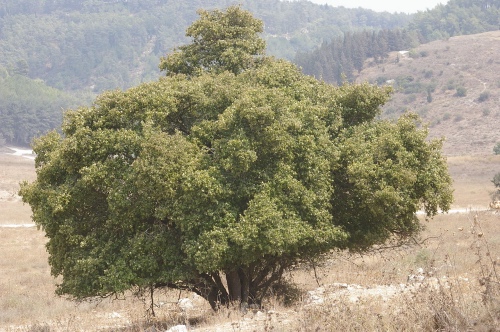
ALVIN JOHNSON takes a look at the tree known as the ‘livneh’…
The word ‘livneh’ only occurs twice in the Old Testament. The NIV translates livneh as the poplar.
The livneh was used by Jacob who placed it in front of his mating animals: “Jacob, however, took fresh-cut branches from livneh (poplar), almond (luz) and plane (armon) trees and made white stripes on them by peeling the bark and exposing the white inner wood of the branches.” – Genesis 30:37
The prophet Hosea mentions how sacrifices to foreign gods were made under the livneh: “They sacrifice on the mountaintops and burn offerings on the hills, under oak (allon), livneh (polar) and terebinth (elah), where the shade is pleasant. Therefore your daughters turn to prostitution and your daughters-in-law to adultery.” – Hosea 4:13

Storax (Styrax officinalis) from the Menashe (Manasseh) hills of Israel. PICTURE: Eitan f/ licenced under CC BY-SA 3.0
There are four main suggestions as to what the livneh could be; three are members of the poplar family.
i. The storax – Styrax officinalis
ii. Euphrates poplar – Populus euphratica
iii. The black poplar or mountain poplar – Populus nigra
iv. The white poplar – Populus alba
The storax (Styrax officinalis) is called livneh in Modern Hebrew. This identification is supported by Nogah Hareuveni and Michael Zohary.
Because the livneh is derived from the Hebrew word ‘lavan’ meaning ‘white’, some argue that it could be the white poplar (Populus alba). Although others say that this is the tsaphtsapha.
Henry Baker Tristram, in his Natural History of the Bible, argued that the livneh referred to the poplar. Writing in 1867, Tristram said, “We observed this tree very common along the banks of the Jordan, and in the lower country, and it derives its specific name from its abundance in that very country where Jacob peeled the rods (Genesis 30:37), the land of Haran, by the Euphrates and the Tigris. Hosea (Hosea 4:12-14), on the contrary, is speaking of a tree on the hills, where we did not meet with the Euphrates Poplar, but where the closely-allied species, P[oplar].alba, grows abundantly. We saw it in various parts of Galilee, Lebanon, and on Mount Hermon”.
However, the white poplar needs ample water so it “grows only in moist ground, not on mountaintops”. So it can be found in the valleys of such places as Mount Hermon. Whereas the storax is found higher up, actually in the mountain areas of Mount Hermon. Therefore, based on the reference from Hosea, that the livneh was found on hilltops, it is doubtful that the livneh is the white poplar and more likely to be the storax.
The storax is not a tall tree, more of a shrub size, growing between two to five metres in height.
In addition the storax exudes milky-white gum and has white flowers, which possibly explains why it has been called the livneh.
The gum obtained from the storax may be the nataph which is translated as ‘gum resin’ in Exodus 30:34. The nataph was one of the ingredients of the incense in the Temple.





